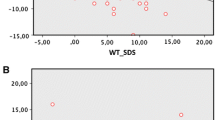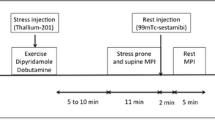Abstract
The results of resting planar ECG-gated technetium-99m methoxyisobutylisonitrile (99mTc-MIBI) imaging were compared with those of thallium-201 (TI) reinjection after exercise-redistribution scintigraphy in 20 patients (19 men, 1 woman, mean age 53±10 years) with angiographically proven coronary artery disease. Eight normal subjects (seven men, one woman, mean age 50±8 years) constituted the control group. In these subjects, only resting99mTc-MIBI imaging was performed. The standardized percent count increase from end-diastole to end-systole was calculated as an index of wall thickening in 13 segments for each study. Regional wall thickening index (WTI) and99mTc-MIBI uptake were significantly different (P<0.05) among segments classified as normal, reversible defects, irreversible defects with increased tracer uptake after re-injection (Re+) or irreversible defects with unchanged tracer uptake after re-injection (Re-) on TI imaging. Furthermore, WTI and99mTc-MIBI uptake were significantly higher (P<0.05) in Resegments with moderate reduction of T1 uptake (≥50% of peak activity) than in Re- segments with severe reduction of TI uptake (<50% of peak activity). A significant relationship between WTI and the results of TI scintigraphy was observed (rho=0.71,P<0.0001). The percentage of Re- segments with severe reduction of WTI was significantly higher compared to Re+ segments (64% vs 3%,P<0.01). Furthermore, compared with moderate Re- segments, a significantly higher percentage of severe Re- segments showed a severe reduction of WTI (86% vs 48%,P<0.01). Our data document a close relationship between99mTc-MIBI regional wall thickening, myocardial perfusion and TI uptake after reinjection. The results of this study suggest that regional WTI decreased significantly as myocardial perfusion decreased. In addition, regional wall thickening was preserved in segments with exercise-induced ischaemia and enhanced TI uptake after re-injection.
Similar content being viewed by others
References
Prohost GM, Zir LM, Moore RM, et al. Differentiation of transiently ischemic from infarcted myocardium by serial imaging after a single dose of thallium-201.Circulation 1979; 55: 294–302.
Gibson RS, Watson DD, Craddock GB, et al. Prediction of cardiac events after uncomplicated myocardial infarction: a prospective study comparing predischarge exercise thallium201 scintigraphy and coronary angiography.Circulation 1983; 68: 321–336.
Kottler TS, Diamond GA. Exercise thallium-201 scintigraphy in the diagnosis and prognosis of coronary artery disease.Ann Intern Med 1990; 113: 684–702.
Dilsizian V, Rocco TP, Freedman NM, Leon MB, Bonow RO. Enhanced detection of ischemic but viable myocardium by the rejection of thallium after stress-redistribution imaging.N Engl J Med 1990; 323: 141–146.
Rocco TP, Dilsizian V, McKusick KA, Fischman AJ, Boucher CA, Strauss HW. Comparison of thallium redistribution with rest “reinjection” imaging for the detection of viable myocardium.Am J Cardiol 1990; 66: 158–163.
Bonow RO, Dilsizian V, Cuocolo A, Bacharach SL. Identification of viable myocardium in patients with coronary artery disease and left ventricular dysfunction: comparison of thallium scintigraphy with reinjection and PET imaging with F-18 fluorodeoxyglucose.Circulation 1991; 83: 26–37.
Ohtani H, Tamaki N, Yonekura Y, et al. Value of thallium-201 reinjection after delayed SPECT imaging for predicting reversible ischemia after coronary artery bypass grafting.Am J Cardiol 1990; 66: 394–399.
Maurea S, Cuocolo A, Nicolai E, Salvatore M. Improved detection of viable myocardium with thallium-201 reinjection in chronic coronary artery disease: comparison with technetium99m-MIBI imaging.J Nucl Med 1994; 35: 621–624.
Kiat H, Maddahi J, Roy LT, et al. Comparison of technetium-99m methoxyisobutyl isonitrile and thallium-201 for evaluation of coronary artery disease by planar and tomographic methods.Am Heart J 1989; 117: 1–11.
Kahn JK, McGhie I, Akers MS, et al. Quantitative rotational tomography with T1-201 and Tc-99m 2-methoxy-isobutyl-isonitrile. A direct comparison in normal individuals and patients with coronary artery disease.Circulation 1989; 79: 1282–1293.
Iskandrian AS, Heo J, Kong B, Lyons E, Marsch S. Use of technetium-99m isonitrile (RP-30A) in assessing left ventricular perfusion and function at rest and during exercise in coronary artery disease, and comparison with coronary arteriography and exercise thallium-201 SPELT imaging.Am J Cardiol 1989; 64: 270–275.
Cuocolo A, Santomauro M, Pace L, et al. Comparison between exercise and trans-oesophageal atrial pacing in patients with coronary artery disease: technetium-99m sestamibi simultaneous evaluation of ventricular function and myocardial perfusion.Eur J Nucl Med 1992; 19: 119–124.
Marcassa C, Marzullo P, Parodi O, Sambuceti G, L'Abbate A. A new method for noninvasive quantitation of segmental myocardial wall thickening using technetium-99m 2-methoxy-isobutyl-isonitrile scintigraphy. Results in normal subjects.J Nucl Med 1990; 31: 173–177.
Pace L, Cuocolo A, Maurea S, et al. Reverse redistribution in resting thallium-201 myocardial scintigraphy in patients with coronary artery disease: relation to coronary anatomy and ventricular function.J Nucl Med 1993; 34: 1688–1692.
Marzullo P, Marcassa C, Parodi O, Sambuceti G, Federghini EM, L'Abbate A. Noninvasive assessment of segmental myocardial wall motion using technetium-99m 2-methoxy-isobutyl-isonitrile scintigraphy.Am J Noninvas Cardiol 1990; 4: 22–28.
Wallestein S, Zucker CL, Fleiss JL. Some statistical methods useful in circulation research.Circ Res 1980; 47: 1–9.
Gelberg HJ, Brundage BH, Glantz S, Parmley WW. Quantitative left ventricular wall motion analysis: a comparison of area, chord and radial methods.Circulation 1979, 59: 991–1000.
Mancini GB, Norris SL, Peterson KL, et al. Quantitative assessment of segmental wall motion abnormalities at rest and after atrialpacing using digital intravenous ventriculography.J Am Coll Cardiol 1983; 2: 70–76.
Haendchen RV, Wyatt HC, Maurer G et al. Quantification of regional myocardial function by two-dimensional echocardiography. I. Patterns of contraction in the normal left ventricle.Circulation 1983; 67: 1234–1245.
Zoghbi WA, Charlot ML, Belli R, et al. End-systolic radius to thickness ratio: an echocardiographic index of regional performance during reversible myocardial ischemia in the conscious dog.J Am Coll Cardiol 1987; 10: 1113–1121.
Lancer P, Garrett J, Lipton MJ, et al. Quantitation of regional myocardial function by cine computed tomography. Pharmacologic changes in wall thickness.J Am Coll Cardiol 1986; 8: 682–692.
Sechtem U, Sommerhof BA, Markiewicz W, White RD, Cheitlin MD, Higgins CB. Regional left ventricular wall thickening by magnetic resonance imaging: evaluation in normal persons and patients with global and regional dysfunction.Am J Cardiol 1987; 59: 145–151.
Mochizuki T, Murase F, Fujiwara Y,Tanada S, Hamamoto K, Tauxe NW. Assessment of systolic thickening with thallium201 ecg-gated single-photon emission computed tomography: a parameter for local left ventricular function.J Nucl Med 1991; 32: 1496–1500.
Yamashita K, Tamaki N, Yonekura Y, et al. Quantitative analysis of regional wall motion by gated myocardial positron emission tomography: validation and comparison with left ventriculography.J Nucl Med 1989; 30: 1775–1786.
Yamashita K, Tamaki N, Yonekura Y, et al. Regional wall thickening of left ventricle evaluated by gated positron emission tomography in relation to myocardial perfusion and glucose metabolism.J Nucl Med 1991; 32: 679–685.
Author information
Authors and Affiliations
Rights and permissions
About this article
Cite this article
Nicolai, E., Cuocolo, A., Pace, L. et al. Assessment of systolic wall thickening using technetium-99m methoxyisobutylisonitrile in patients with coronary artery disease: relation to thallium-201 scintigraphy with re-injection. Eur J Nucl Med 22, 1017–1022 (1995). https://doi.org/10.1007/BF00808413
Received:
Revised:
Issue Date:
DOI: https://doi.org/10.1007/BF00808413




